Global Warming, Human Rights, and Politics: Nuatambu Island Case Study
VerifiedAdded on 2020/05/11
|8
|2298
|156
Case Study
AI Summary
This case study examines the impact of global warming on Nuatambu Island in the Solomon Islands, focusing on rising sea levels, coastal erosion, and the displacement of communities. It explores the geographical, demographic, and socio-economic structures of the island, highlighting the reliance on natural resources and the challenges posed by climate change. The study details the disappearance of islands, the loss of habitable land, and the resulting human rights implications, including threats to food security and livelihoods. It also discusses international responses, geopolitical factors, and the need for adaptation strategies and financial aid to address the crisis. The case study emphasizes the need for global cooperation and assistance to protect the human rights of those affected by climate change, particularly in vulnerable island nations like the Solomon Islands. The study also highlights the role of global politics, particularly the involvement of countries like Canada and the United States, in addressing the crisis and providing aid.
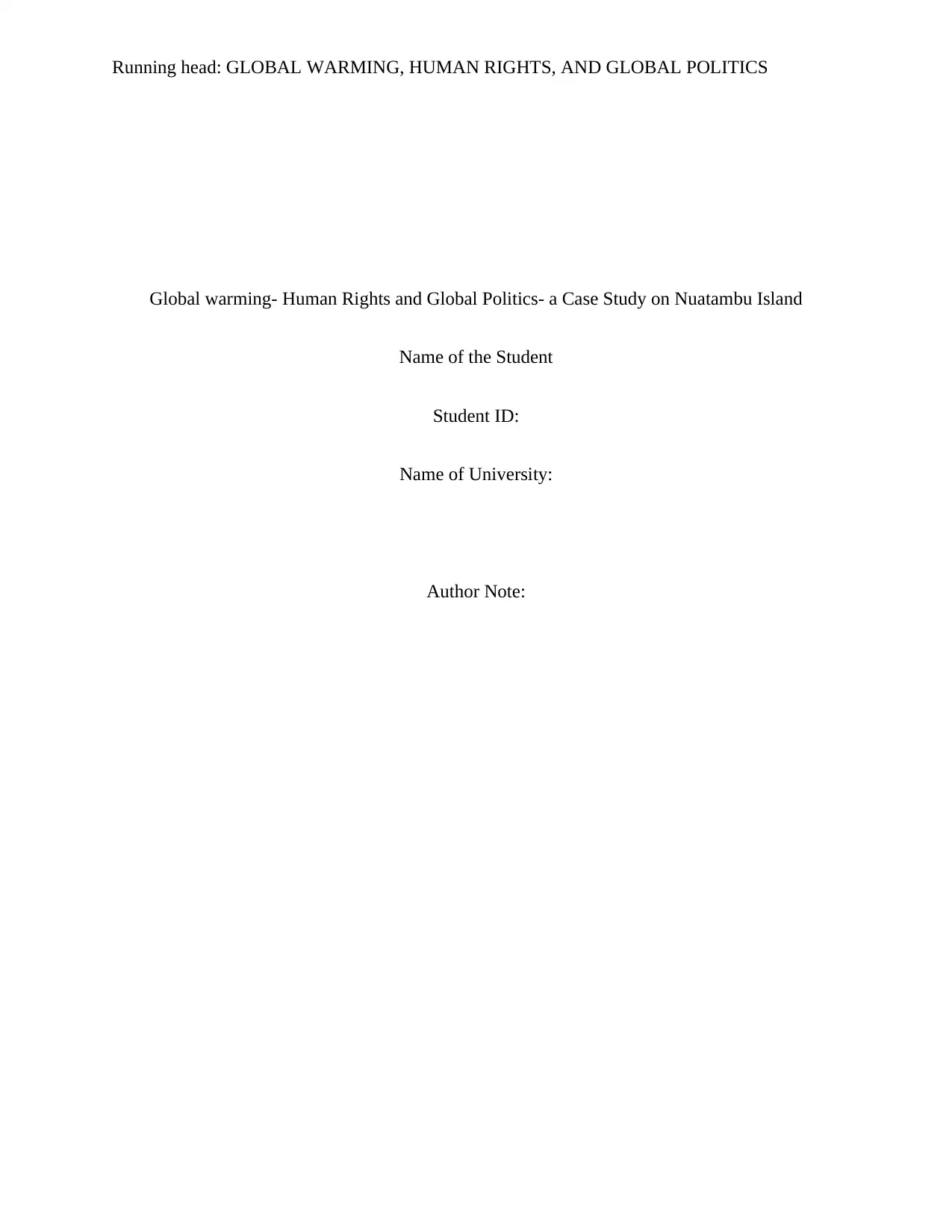
Running head: GLOBAL WARMING, HUMAN RIGHTS, AND GLOBAL POLITICS
Global warming- Human Rights and Global Politics- a Case Study on Nuatambu Island
Name of the Student
Student ID:
Name of University:
Author Note:
Global warming- Human Rights and Global Politics- a Case Study on Nuatambu Island
Name of the Student
Student ID:
Name of University:
Author Note:
Paraphrase This Document
Need a fresh take? Get an instant paraphrase of this document with our AI Paraphraser
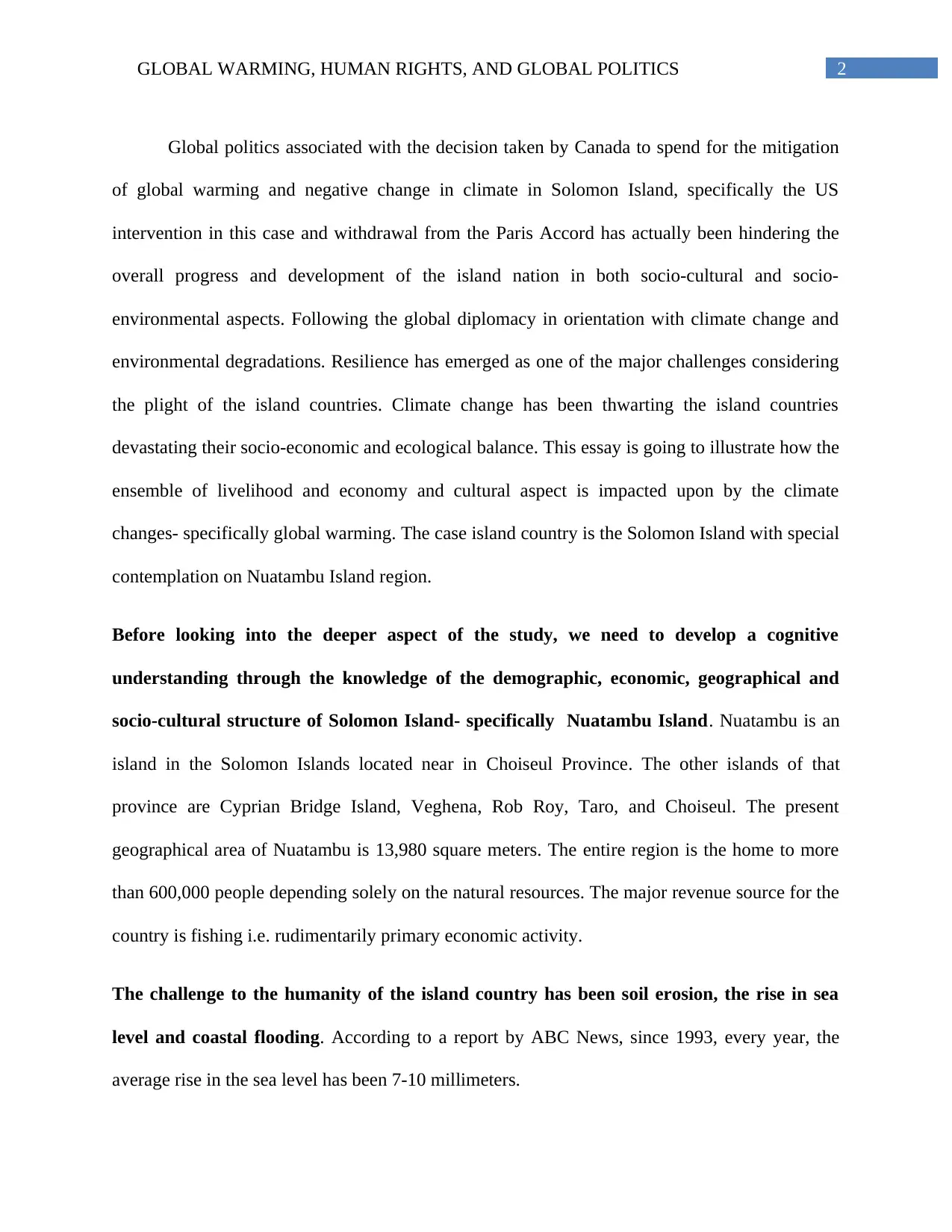
2GLOBAL WARMING, HUMAN RIGHTS, AND GLOBAL POLITICS
Global politics associated with the decision taken by Canada to spend for the mitigation
of global warming and negative change in climate in Solomon Island, specifically the US
intervention in this case and withdrawal from the Paris Accord has actually been hindering the
overall progress and development of the island nation in both socio-cultural and socio-
environmental aspects. Following the global diplomacy in orientation with climate change and
environmental degradations. Resilience has emerged as one of the major challenges considering
the plight of the island countries. Climate change has been thwarting the island countries
devastating their socio-economic and ecological balance. This essay is going to illustrate how the
ensemble of livelihood and economy and cultural aspect is impacted upon by the climate
changes- specifically global warming. The case island country is the Solomon Island with special
contemplation on Nuatambu Island region.
Before looking into the deeper aspect of the study, we need to develop a cognitive
understanding through the knowledge of the demographic, economic, geographical and
socio-cultural structure of Solomon Island- specifically Nuatambu Island. Nuatambu is an
island in the Solomon Islands located near in Choiseul Province. The other islands of that
province are Cyprian Bridge Island, Veghena, Rob Roy, Taro, and Choiseul. The present
geographical area of Nuatambu is 13,980 square meters. The entire region is the home to more
than 600,000 people depending solely on the natural resources. The major revenue source for the
country is fishing i.e. rudimentarily primary economic activity.
The challenge to the humanity of the island country has been soil erosion, the rise in sea
level and coastal flooding. According to a report by ABC News, since 1993, every year, the
average rise in the sea level has been 7-10 millimeters.
Global politics associated with the decision taken by Canada to spend for the mitigation
of global warming and negative change in climate in Solomon Island, specifically the US
intervention in this case and withdrawal from the Paris Accord has actually been hindering the
overall progress and development of the island nation in both socio-cultural and socio-
environmental aspects. Following the global diplomacy in orientation with climate change and
environmental degradations. Resilience has emerged as one of the major challenges considering
the plight of the island countries. Climate change has been thwarting the island countries
devastating their socio-economic and ecological balance. This essay is going to illustrate how the
ensemble of livelihood and economy and cultural aspect is impacted upon by the climate
changes- specifically global warming. The case island country is the Solomon Island with special
contemplation on Nuatambu Island region.
Before looking into the deeper aspect of the study, we need to develop a cognitive
understanding through the knowledge of the demographic, economic, geographical and
socio-cultural structure of Solomon Island- specifically Nuatambu Island. Nuatambu is an
island in the Solomon Islands located near in Choiseul Province. The other islands of that
province are Cyprian Bridge Island, Veghena, Rob Roy, Taro, and Choiseul. The present
geographical area of Nuatambu is 13,980 square meters. The entire region is the home to more
than 600,000 people depending solely on the natural resources. The major revenue source for the
country is fishing i.e. rudimentarily primary economic activity.
The challenge to the humanity of the island country has been soil erosion, the rise in sea
level and coastal flooding. According to a report by ABC News, since 1993, every year, the
average rise in the sea level has been 7-10 millimeters.
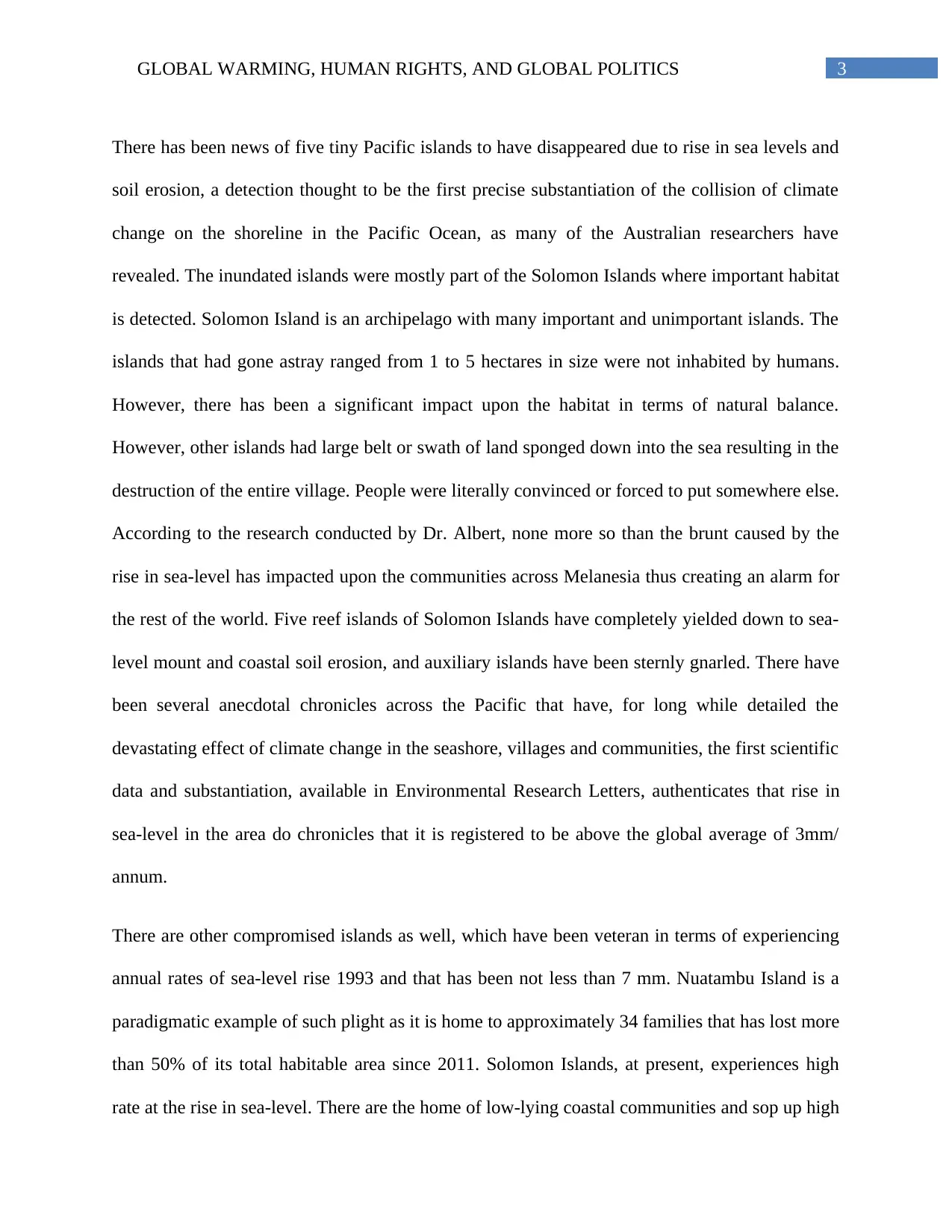
3GLOBAL WARMING, HUMAN RIGHTS, AND GLOBAL POLITICS
There has been news of five tiny Pacific islands to have disappeared due to rise in sea levels and
soil erosion, a detection thought to be the first precise substantiation of the collision of climate
change on the shoreline in the Pacific Ocean, as many of the Australian researchers have
revealed. The inundated islands were mostly part of the Solomon Islands where important habitat
is detected. Solomon Island is an archipelago with many important and unimportant islands. The
islands that had gone astray ranged from 1 to 5 hectares in size were not inhabited by humans.
However, there has been a significant impact upon the habitat in terms of natural balance.
However, other islands had large belt or swath of land sponged down into the sea resulting in the
destruction of the entire village. People were literally convinced or forced to put somewhere else.
According to the research conducted by Dr. Albert, none more so than the brunt caused by the
rise in sea-level has impacted upon the communities across Melanesia thus creating an alarm for
the rest of the world. Five reef islands of Solomon Islands have completely yielded down to sea-
level mount and coastal soil erosion, and auxiliary islands have been sternly gnarled. There have
been several anecdotal chronicles across the Pacific that have, for long while detailed the
devastating effect of climate change in the seashore, villages and communities, the first scientific
data and substantiation, available in Environmental Research Letters, authenticates that rise in
sea-level in the area do chronicles that it is registered to be above the global average of 3mm/
annum.
There are other compromised islands as well, which have been veteran in terms of experiencing
annual rates of sea-level rise 1993 and that has been not less than 7 mm. Nuatambu Island is a
paradigmatic example of such plight as it is home to approximately 34 families that has lost more
than 50% of its total habitable area since 2011. Solomon Islands, at present, experiences high
rate at the rise in sea-level. There are the home of low-lying coastal communities and sop up high
There has been news of five tiny Pacific islands to have disappeared due to rise in sea levels and
soil erosion, a detection thought to be the first precise substantiation of the collision of climate
change on the shoreline in the Pacific Ocean, as many of the Australian researchers have
revealed. The inundated islands were mostly part of the Solomon Islands where important habitat
is detected. Solomon Island is an archipelago with many important and unimportant islands. The
islands that had gone astray ranged from 1 to 5 hectares in size were not inhabited by humans.
However, there has been a significant impact upon the habitat in terms of natural balance.
However, other islands had large belt or swath of land sponged down into the sea resulting in the
destruction of the entire village. People were literally convinced or forced to put somewhere else.
According to the research conducted by Dr. Albert, none more so than the brunt caused by the
rise in sea-level has impacted upon the communities across Melanesia thus creating an alarm for
the rest of the world. Five reef islands of Solomon Islands have completely yielded down to sea-
level mount and coastal soil erosion, and auxiliary islands have been sternly gnarled. There have
been several anecdotal chronicles across the Pacific that have, for long while detailed the
devastating effect of climate change in the seashore, villages and communities, the first scientific
data and substantiation, available in Environmental Research Letters, authenticates that rise in
sea-level in the area do chronicles that it is registered to be above the global average of 3mm/
annum.
There are other compromised islands as well, which have been veteran in terms of experiencing
annual rates of sea-level rise 1993 and that has been not less than 7 mm. Nuatambu Island is a
paradigmatic example of such plight as it is home to approximately 34 families that has lost more
than 50% of its total habitable area since 2011. Solomon Islands, at present, experiences high
rate at the rise in sea-level. There are the home of low-lying coastal communities and sop up high
⊘ This is a preview!⊘
Do you want full access?
Subscribe today to unlock all pages.

Trusted by 1+ million students worldwide
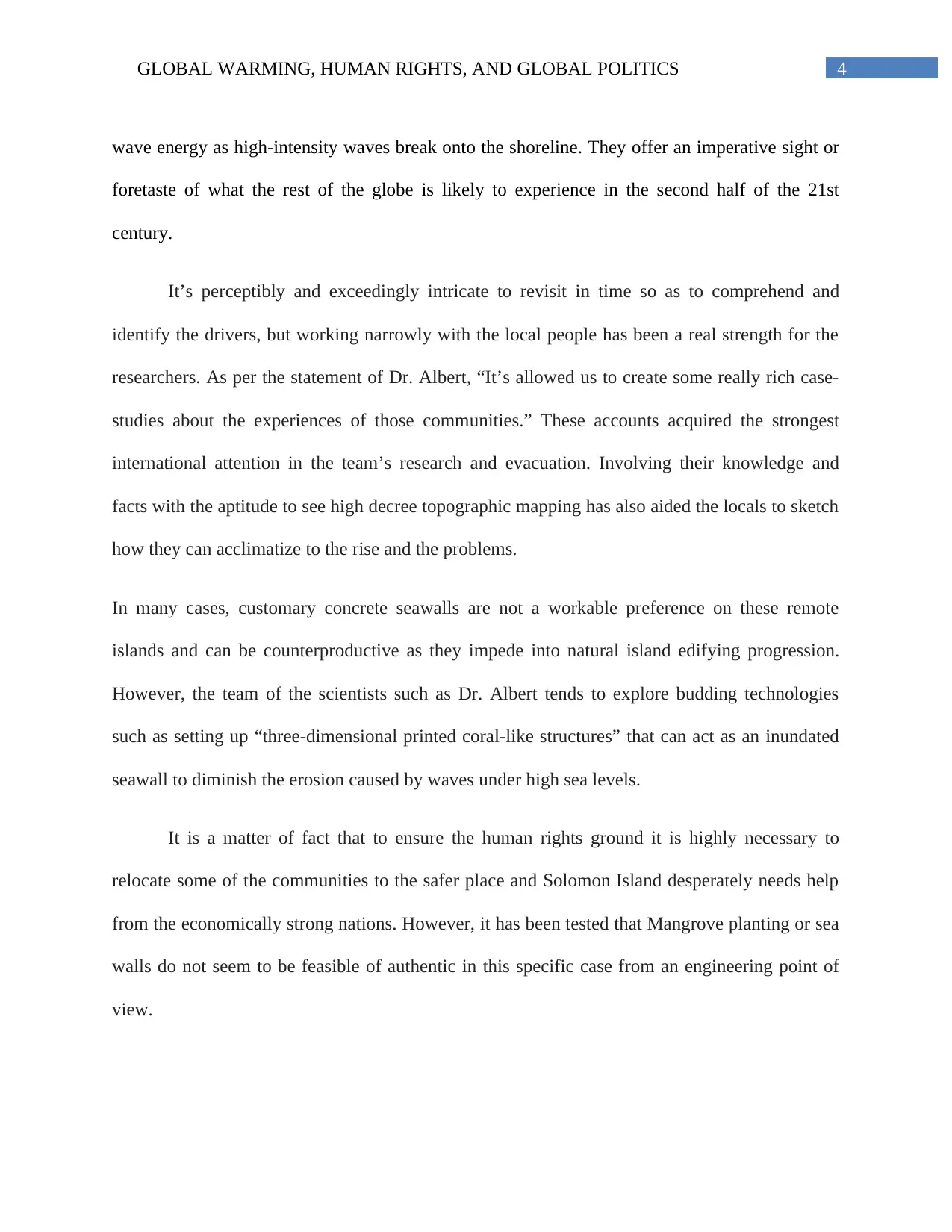
4GLOBAL WARMING, HUMAN RIGHTS, AND GLOBAL POLITICS
wave energy as high-intensity waves break onto the shoreline. They offer an imperative sight or
foretaste of what the rest of the globe is likely to experience in the second half of the 21st
century.
It’s perceptibly and exceedingly intricate to revisit in time so as to comprehend and
identify the drivers, but working narrowly with the local people has been a real strength for the
researchers. As per the statement of Dr. Albert, “It’s allowed us to create some really rich case-
studies about the experiences of those communities.” These accounts acquired the strongest
international attention in the team’s research and evacuation. Involving their knowledge and
facts with the aptitude to see high decree topographic mapping has also aided the locals to sketch
how they can acclimatize to the rise and the problems.
In many cases, customary concrete seawalls are not a workable preference on these remote
islands and can be counterproductive as they impede into natural island edifying progression.
However, the team of the scientists such as Dr. Albert tends to explore budding technologies
such as setting up “three-dimensional printed coral-like structures” that can act as an inundated
seawall to diminish the erosion caused by waves under high sea levels.
It is a matter of fact that to ensure the human rights ground it is highly necessary to
relocate some of the communities to the safer place and Solomon Island desperately needs help
from the economically strong nations. However, it has been tested that Mangrove planting or sea
walls do not seem to be feasible of authentic in this specific case from an engineering point of
view.
wave energy as high-intensity waves break onto the shoreline. They offer an imperative sight or
foretaste of what the rest of the globe is likely to experience in the second half of the 21st
century.
It’s perceptibly and exceedingly intricate to revisit in time so as to comprehend and
identify the drivers, but working narrowly with the local people has been a real strength for the
researchers. As per the statement of Dr. Albert, “It’s allowed us to create some really rich case-
studies about the experiences of those communities.” These accounts acquired the strongest
international attention in the team’s research and evacuation. Involving their knowledge and
facts with the aptitude to see high decree topographic mapping has also aided the locals to sketch
how they can acclimatize to the rise and the problems.
In many cases, customary concrete seawalls are not a workable preference on these remote
islands and can be counterproductive as they impede into natural island edifying progression.
However, the team of the scientists such as Dr. Albert tends to explore budding technologies
such as setting up “three-dimensional printed coral-like structures” that can act as an inundated
seawall to diminish the erosion caused by waves under high sea levels.
It is a matter of fact that to ensure the human rights ground it is highly necessary to
relocate some of the communities to the safer place and Solomon Island desperately needs help
from the economically strong nations. However, it has been tested that Mangrove planting or sea
walls do not seem to be feasible of authentic in this specific case from an engineering point of
view.
Paraphrase This Document
Need a fresh take? Get an instant paraphrase of this document with our AI Paraphraser
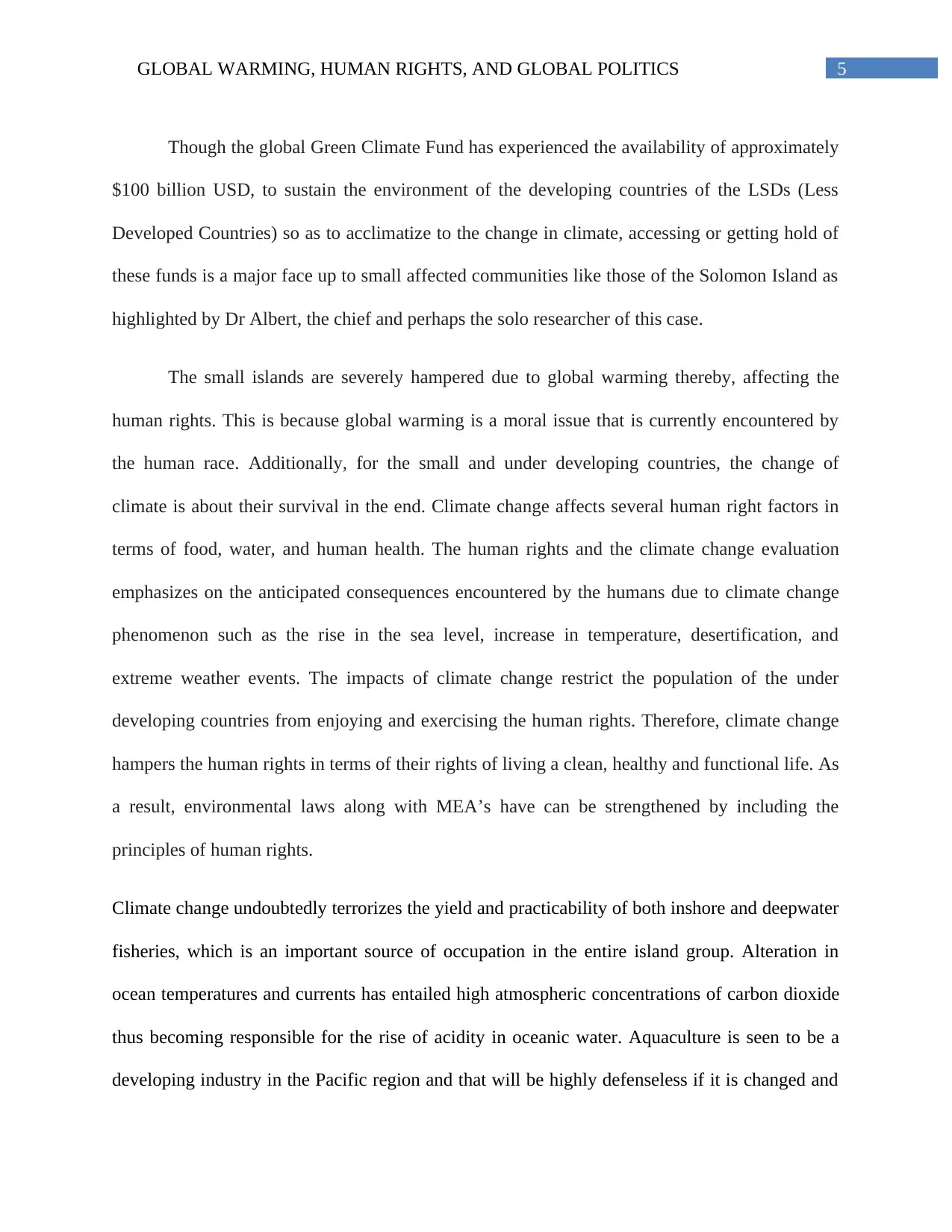
5GLOBAL WARMING, HUMAN RIGHTS, AND GLOBAL POLITICS
Though the global Green Climate Fund has experienced the availability of approximately
$100 billion USD, to sustain the environment of the developing countries of the LSDs (Less
Developed Countries) so as to acclimatize to the change in climate, accessing or getting hold of
these funds is a major face up to small affected communities like those of the Solomon Island as
highlighted by Dr Albert, the chief and perhaps the solo researcher of this case.
The small islands are severely hampered due to global warming thereby, affecting the
human rights. This is because global warming is a moral issue that is currently encountered by
the human race. Additionally, for the small and under developing countries, the change of
climate is about their survival in the end. Climate change affects several human right factors in
terms of food, water, and human health. The human rights and the climate change evaluation
emphasizes on the anticipated consequences encountered by the humans due to climate change
phenomenon such as the rise in the sea level, increase in temperature, desertification, and
extreme weather events. The impacts of climate change restrict the population of the under
developing countries from enjoying and exercising the human rights. Therefore, climate change
hampers the human rights in terms of their rights of living a clean, healthy and functional life. As
a result, environmental laws along with MEA’s have can be strengthened by including the
principles of human rights.
Climate change undoubtedly terrorizes the yield and practicability of both inshore and deepwater
fisheries, which is an important source of occupation in the entire island group. Alteration in
ocean temperatures and currents has entailed high atmospheric concentrations of carbon dioxide
thus becoming responsible for the rise of acidity in oceanic water. Aquaculture is seen to be a
developing industry in the Pacific region and that will be highly defenseless if it is changed and
Though the global Green Climate Fund has experienced the availability of approximately
$100 billion USD, to sustain the environment of the developing countries of the LSDs (Less
Developed Countries) so as to acclimatize to the change in climate, accessing or getting hold of
these funds is a major face up to small affected communities like those of the Solomon Island as
highlighted by Dr Albert, the chief and perhaps the solo researcher of this case.
The small islands are severely hampered due to global warming thereby, affecting the
human rights. This is because global warming is a moral issue that is currently encountered by
the human race. Additionally, for the small and under developing countries, the change of
climate is about their survival in the end. Climate change affects several human right factors in
terms of food, water, and human health. The human rights and the climate change evaluation
emphasizes on the anticipated consequences encountered by the humans due to climate change
phenomenon such as the rise in the sea level, increase in temperature, desertification, and
extreme weather events. The impacts of climate change restrict the population of the under
developing countries from enjoying and exercising the human rights. Therefore, climate change
hampers the human rights in terms of their rights of living a clean, healthy and functional life. As
a result, environmental laws along with MEA’s have can be strengthened by including the
principles of human rights.
Climate change undoubtedly terrorizes the yield and practicability of both inshore and deepwater
fisheries, which is an important source of occupation in the entire island group. Alteration in
ocean temperatures and currents has entailed high atmospheric concentrations of carbon dioxide
thus becoming responsible for the rise of acidity in oceanic water. Aquaculture is seen to be a
developing industry in the Pacific region and that will be highly defenseless if it is changed and
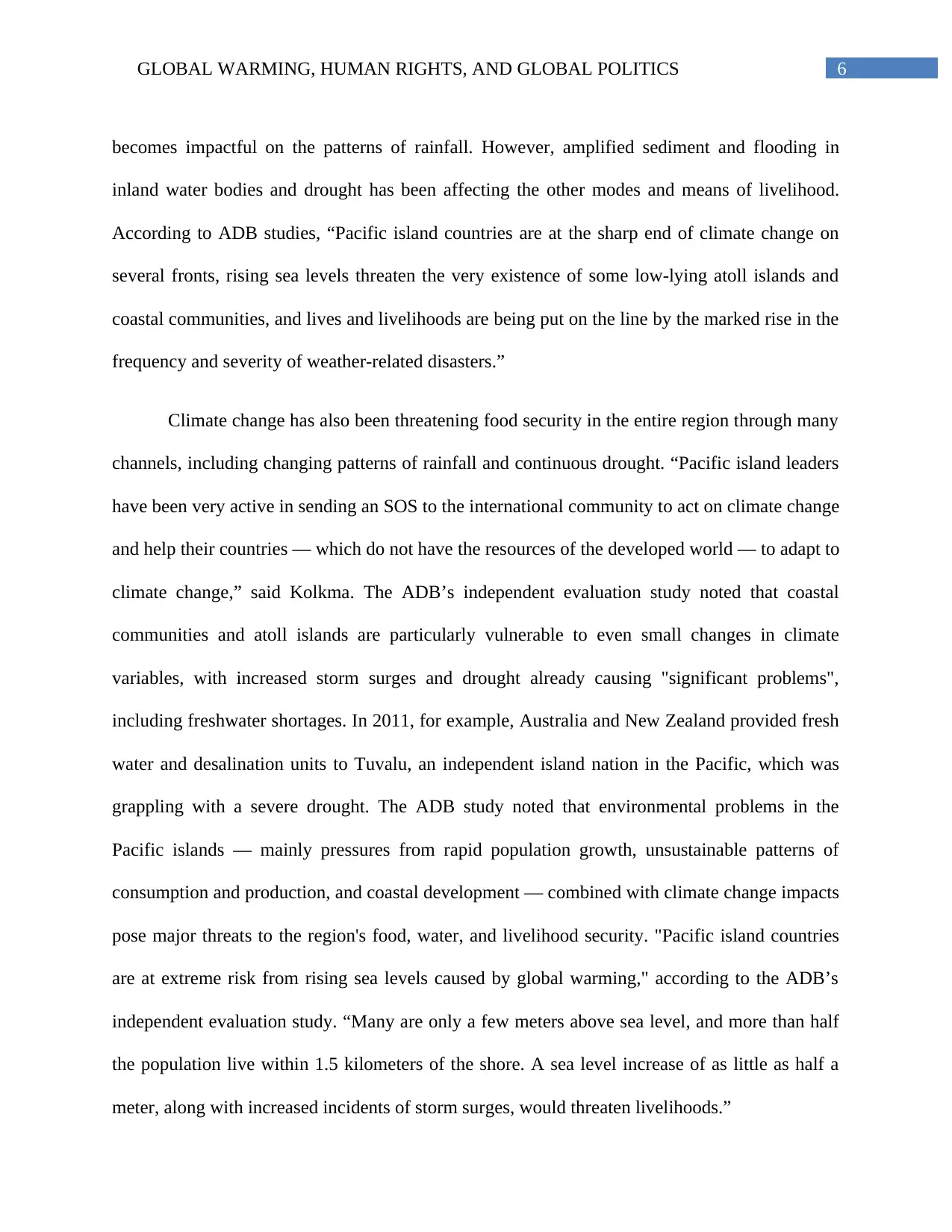
6GLOBAL WARMING, HUMAN RIGHTS, AND GLOBAL POLITICS
becomes impactful on the patterns of rainfall. However, amplified sediment and flooding in
inland water bodies and drought has been affecting the other modes and means of livelihood.
According to ADB studies, “Pacific island countries are at the sharp end of climate change on
several fronts, rising sea levels threaten the very existence of some low-lying atoll islands and
coastal communities, and lives and livelihoods are being put on the line by the marked rise in the
frequency and severity of weather-related disasters.”
Climate change has also been threatening food security in the entire region through many
channels, including changing patterns of rainfall and continuous drought. “Pacific island leaders
have been very active in sending an SOS to the international community to act on climate change
and help their countries — which do not have the resources of the developed world — to adapt to
climate change,” said Kolkma. The ADB’s independent evaluation study noted that coastal
communities and atoll islands are particularly vulnerable to even small changes in climate
variables, with increased storm surges and drought already causing "significant problems",
including freshwater shortages. In 2011, for example, Australia and New Zealand provided fresh
water and desalination units to Tuvalu, an independent island nation in the Pacific, which was
grappling with a severe drought. The ADB study noted that environmental problems in the
Pacific islands — mainly pressures from rapid population growth, unsustainable patterns of
consumption and production, and coastal development — combined with climate change impacts
pose major threats to the region's food, water, and livelihood security. "Pacific island countries
are at extreme risk from rising sea levels caused by global warming," according to the ADB’s
independent evaluation study. “Many are only a few meters above sea level, and more than half
the population live within 1.5 kilometers of the shore. A sea level increase of as little as half a
meter, along with increased incidents of storm surges, would threaten livelihoods.”
becomes impactful on the patterns of rainfall. However, amplified sediment and flooding in
inland water bodies and drought has been affecting the other modes and means of livelihood.
According to ADB studies, “Pacific island countries are at the sharp end of climate change on
several fronts, rising sea levels threaten the very existence of some low-lying atoll islands and
coastal communities, and lives and livelihoods are being put on the line by the marked rise in the
frequency and severity of weather-related disasters.”
Climate change has also been threatening food security in the entire region through many
channels, including changing patterns of rainfall and continuous drought. “Pacific island leaders
have been very active in sending an SOS to the international community to act on climate change
and help their countries — which do not have the resources of the developed world — to adapt to
climate change,” said Kolkma. The ADB’s independent evaluation study noted that coastal
communities and atoll islands are particularly vulnerable to even small changes in climate
variables, with increased storm surges and drought already causing "significant problems",
including freshwater shortages. In 2011, for example, Australia and New Zealand provided fresh
water and desalination units to Tuvalu, an independent island nation in the Pacific, which was
grappling with a severe drought. The ADB study noted that environmental problems in the
Pacific islands — mainly pressures from rapid population growth, unsustainable patterns of
consumption and production, and coastal development — combined with climate change impacts
pose major threats to the region's food, water, and livelihood security. "Pacific island countries
are at extreme risk from rising sea levels caused by global warming," according to the ADB’s
independent evaluation study. “Many are only a few meters above sea level, and more than half
the population live within 1.5 kilometers of the shore. A sea level increase of as little as half a
meter, along with increased incidents of storm surges, would threaten livelihoods.”
⊘ This is a preview!⊘
Do you want full access?
Subscribe today to unlock all pages.

Trusted by 1+ million students worldwide
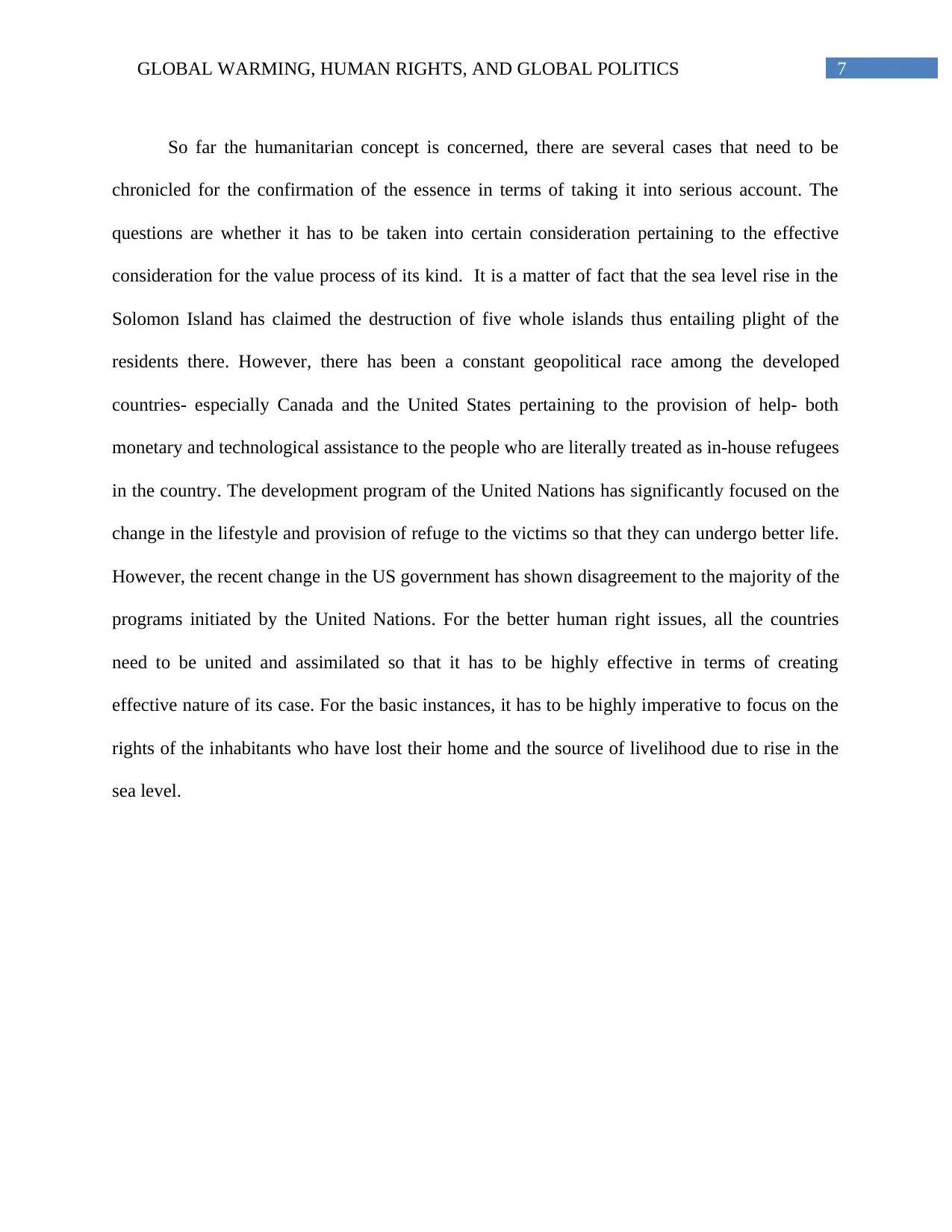
7GLOBAL WARMING, HUMAN RIGHTS, AND GLOBAL POLITICS
So far the humanitarian concept is concerned, there are several cases that need to be
chronicled for the confirmation of the essence in terms of taking it into serious account. The
questions are whether it has to be taken into certain consideration pertaining to the effective
consideration for the value process of its kind. It is a matter of fact that the sea level rise in the
Solomon Island has claimed the destruction of five whole islands thus entailing plight of the
residents there. However, there has been a constant geopolitical race among the developed
countries- especially Canada and the United States pertaining to the provision of help- both
monetary and technological assistance to the people who are literally treated as in-house refugees
in the country. The development program of the United Nations has significantly focused on the
change in the lifestyle and provision of refuge to the victims so that they can undergo better life.
However, the recent change in the US government has shown disagreement to the majority of the
programs initiated by the United Nations. For the better human right issues, all the countries
need to be united and assimilated so that it has to be highly effective in terms of creating
effective nature of its case. For the basic instances, it has to be highly imperative to focus on the
rights of the inhabitants who have lost their home and the source of livelihood due to rise in the
sea level.
So far the humanitarian concept is concerned, there are several cases that need to be
chronicled for the confirmation of the essence in terms of taking it into serious account. The
questions are whether it has to be taken into certain consideration pertaining to the effective
consideration for the value process of its kind. It is a matter of fact that the sea level rise in the
Solomon Island has claimed the destruction of five whole islands thus entailing plight of the
residents there. However, there has been a constant geopolitical race among the developed
countries- especially Canada and the United States pertaining to the provision of help- both
monetary and technological assistance to the people who are literally treated as in-house refugees
in the country. The development program of the United Nations has significantly focused on the
change in the lifestyle and provision of refuge to the victims so that they can undergo better life.
However, the recent change in the US government has shown disagreement to the majority of the
programs initiated by the United Nations. For the better human right issues, all the countries
need to be united and assimilated so that it has to be highly effective in terms of creating
effective nature of its case. For the basic instances, it has to be highly imperative to focus on the
rights of the inhabitants who have lost their home and the source of livelihood due to rise in the
sea level.
Paraphrase This Document
Need a fresh take? Get an instant paraphrase of this document with our AI Paraphraser
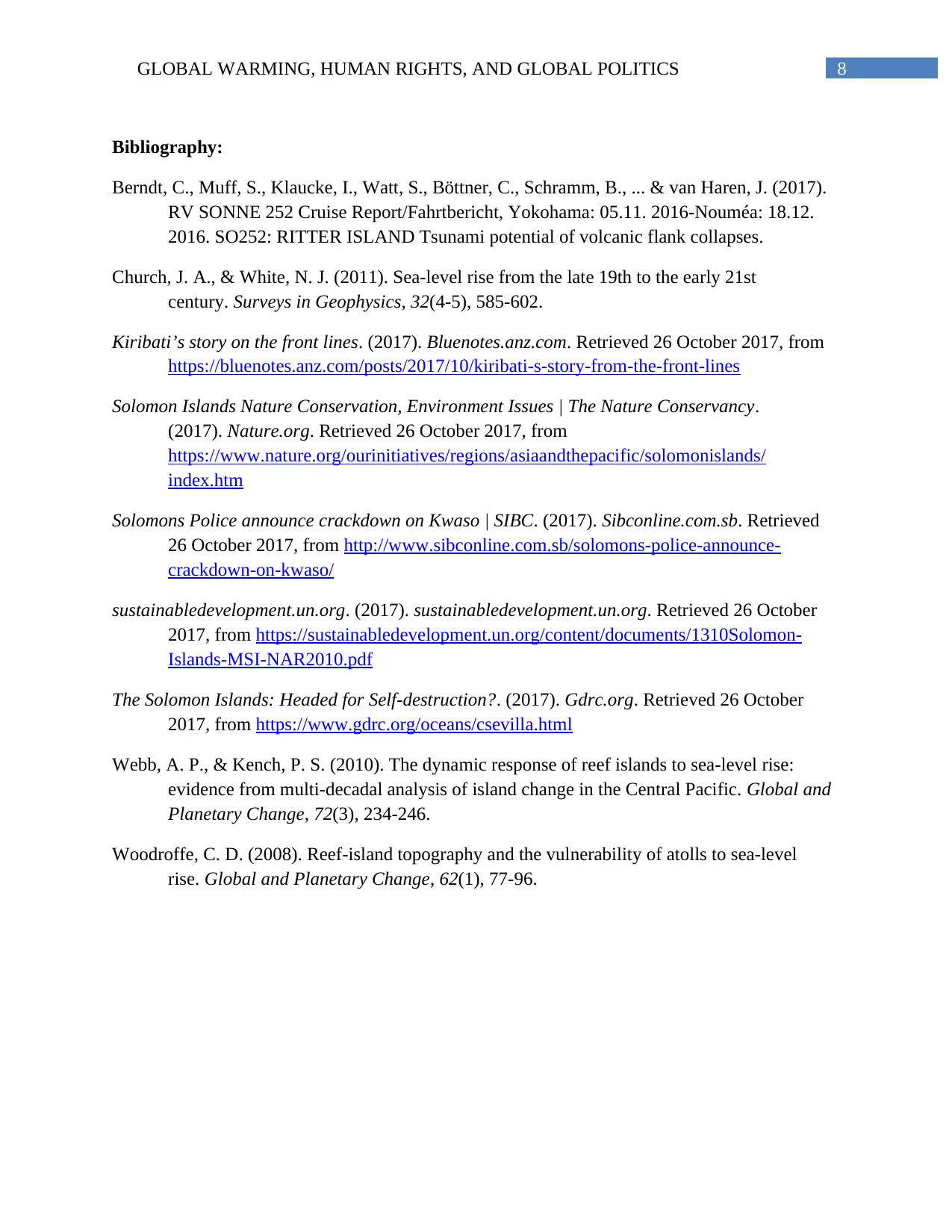
8GLOBAL WARMING, HUMAN RIGHTS, AND GLOBAL POLITICS
Bibliography:
Berndt, C., Muff, S., Klaucke, I., Watt, S., Böttner, C., Schramm, B., ... & van Haren, J. (2017).
RV SONNE 252 Cruise Report/Fahrtbericht, Yokohama: 05.11. 2016-Nouméa: 18.12.
2016. SO252: RITTER ISLAND Tsunami potential of volcanic flank collapses.
Church, J. A., & White, N. J. (2011). Sea-level rise from the late 19th to the early 21st
century. Surveys in Geophysics, 32(4-5), 585-602.
Kiribati’s story on the front lines. (2017). Bluenotes.anz.com. Retrieved 26 October 2017, from
https://bluenotes.anz.com/posts/2017/10/kiribati-s-story-from-the-front-lines
Solomon Islands Nature Conservation, Environment Issues | The Nature Conservancy.
(2017). Nature.org. Retrieved 26 October 2017, from
https://www.nature.org/ourinitiatives/regions/asiaandthepacific/solomonislands/
index.htm
Solomons Police announce crackdown on Kwaso | SIBC. (2017). Sibconline.com.sb. Retrieved
26 October 2017, from http://www.sibconline.com.sb/solomons-police-announce-
crackdown-on-kwaso/
sustainabledevelopment.un.org. (2017). sustainabledevelopment.un.org. Retrieved 26 October
2017, from https://sustainabledevelopment.un.org/content/documents/1310Solomon-
Islands-MSI-NAR2010.pdf
The Solomon Islands: Headed for Self-destruction?. (2017). Gdrc.org. Retrieved 26 October
2017, from https://www.gdrc.org/oceans/csevilla.html
Webb, A. P., & Kench, P. S. (2010). The dynamic response of reef islands to sea-level rise:
evidence from multi-decadal analysis of island change in the Central Pacific. Global and
Planetary Change, 72(3), 234-246.
Woodroffe, C. D. (2008). Reef-island topography and the vulnerability of atolls to sea-level
rise. Global and Planetary Change, 62(1), 77-96.
Bibliography:
Berndt, C., Muff, S., Klaucke, I., Watt, S., Böttner, C., Schramm, B., ... & van Haren, J. (2017).
RV SONNE 252 Cruise Report/Fahrtbericht, Yokohama: 05.11. 2016-Nouméa: 18.12.
2016. SO252: RITTER ISLAND Tsunami potential of volcanic flank collapses.
Church, J. A., & White, N. J. (2011). Sea-level rise from the late 19th to the early 21st
century. Surveys in Geophysics, 32(4-5), 585-602.
Kiribati’s story on the front lines. (2017). Bluenotes.anz.com. Retrieved 26 October 2017, from
https://bluenotes.anz.com/posts/2017/10/kiribati-s-story-from-the-front-lines
Solomon Islands Nature Conservation, Environment Issues | The Nature Conservancy.
(2017). Nature.org. Retrieved 26 October 2017, from
https://www.nature.org/ourinitiatives/regions/asiaandthepacific/solomonislands/
index.htm
Solomons Police announce crackdown on Kwaso | SIBC. (2017). Sibconline.com.sb. Retrieved
26 October 2017, from http://www.sibconline.com.sb/solomons-police-announce-
crackdown-on-kwaso/
sustainabledevelopment.un.org. (2017). sustainabledevelopment.un.org. Retrieved 26 October
2017, from https://sustainabledevelopment.un.org/content/documents/1310Solomon-
Islands-MSI-NAR2010.pdf
The Solomon Islands: Headed for Self-destruction?. (2017). Gdrc.org. Retrieved 26 October
2017, from https://www.gdrc.org/oceans/csevilla.html
Webb, A. P., & Kench, P. S. (2010). The dynamic response of reef islands to sea-level rise:
evidence from multi-decadal analysis of island change in the Central Pacific. Global and
Planetary Change, 72(3), 234-246.
Woodroffe, C. D. (2008). Reef-island topography and the vulnerability of atolls to sea-level
rise. Global and Planetary Change, 62(1), 77-96.
1 out of 8
Related Documents
Your All-in-One AI-Powered Toolkit for Academic Success.
+13062052269
info@desklib.com
Available 24*7 on WhatsApp / Email
![[object Object]](/_next/static/media/star-bottom.7253800d.svg)
Unlock your academic potential
Copyright © 2020–2025 A2Z Services. All Rights Reserved. Developed and managed by ZUCOL.





